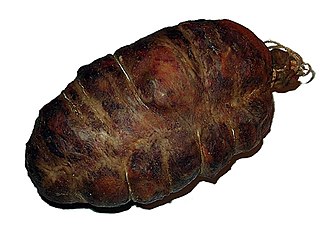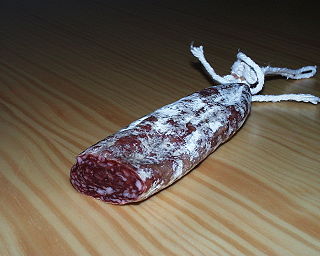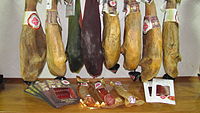
Spanish cuisine consists of the traditions and practices of Spanish cooking. It features considerable regional diversity, with important differences between the traditions of each of Spain's regional cuisines.

Catalan cuisine is the cuisine from Catalonia. It may also refer to the shared cuisine of Northern Catalonia and Andorra, the second of which has a similar cuisine to that of the neighbouring Alt Urgell and Cerdanya comarques and which is often referred to as "Catalan mountain cuisine". It is considered a part of western Mediterranean cuisine.

A sausage is a type of meat product usually made from ground meat—often pork, beef, or poultry—along with salt, spices and other flavourings. Other ingredients, such as grains or breadcrumbs may be included as fillers or extenders.

Botifarra is a type of sausage and one of the most important dishes of the Catalan cuisine.

Tripe is a type of edible lining from the stomachs of various farm animals. Most tripe is from cattle, pigs and sheep.

A blood sausage is a sausage filled with blood that is cooked or dried and mixed with a filler until it is thick enough to solidify when cooled. Most commonly, the blood of pigs, sheep, lamb, cow, chicken, or goose is used.

Chorizo is a type of pork sausage originating from the Iberian Peninsula. It is made in many national and regional varieties in several countries on different continents. Some of these varieties are quite different from each other, occasionally leading to confusion or disagreements over the names and identities of the products in question.

Offal, also called variety meats, pluck or organ meats, is the internal organs of a butchered animal. The word does not refer to a particular list of edible organs, and these lists of organs vary with culture and region, but usually exclude skeletal muscle. Offal may also refer to the by-products of milled grains, such as corn or wheat.

The oldest known book on Portuguese cuisine, entitled Livro de Cozinha da Infanta D. Maria de Portugal, from the 16th century, describes many popular dishes of meat, fish, poultry and others.

Sobrassada in Catalan, or sobrasada in Spanish, is a raw, cured sausage from the Balearic Islands (Spain) made with ground pork, paprika, salt and other spices. sobrassada, along with botifarró, are traditional Balearic meat products prepared in the laborious but festive rites that still mark the autumn and winter pig slaughter known as a matança in Minorca, Majorca and Ibiza. The chemical principle that makes sobrassada is the dehydration of meat under certain weather conditions which are typical of the late Balearic autumn.

Botillo, Butiellu or Botelo is a dish of meat-stuffed pork intestine. It is a culinary specialty of El Bierzo, a county in the Spanish province of León and also of the region of Trás-os-Montes, in Portugal. The Spanish term botillo, the Portuguese term botelo and Leonese term butiellu derive from the Latin word botellus, meaning intestine.

Longaniza is a Spanish sausage (embutido) similar to a chorizo and also closely associated with the Portuguese linguiça. Its defining characteristics are interpreted differently from region to region. It is popular in the cuisines of several regions of Spain, Argentina, Uruguay, Puerto Rico, Dominican Republic, El Salvador, Guatemala, Mexico and Chile. In the Philippines, it is called longganisa and has hundreds of variants with different vernacular tastes and forms due to the 144 ethno-linguistic groups of the archipelago. Longaniza essentially tracks the spread of Latin culture around the world. Longaniza derives from Lucanica, a sausage from Lucania in Southern Italy that was adopted by the Latins of Ancient Rome through military contact. From there it spread to Spain, and from Spain, centuries later, to every place in the world with modern "Latin" culture.
Leonese cuisine is a sub category of Spanish cuisine from the Province of León.

Cocido or cozido is a traditional stew eaten as a main dish in Spain, Portugal, Brazil and other Hispanophone and Lusophone countries.

Butifarra Soledeña is a type of botifarra that has developed into a regional specialty in Colombian cuisine. It is made from ground beef and pork with seasoning and spices. The meat is cut into pieces and boiled. The mixture is encased in intestine and tied off with string into sections. The lengths are boiled. Butifarras Soledeñas are hawked in the street by vendors calling out "buti, buti, buti" while drumming on the metal containers from which they are sold. Butifarras Soledeñas are often offered with fresh squeezed lime juice.

Embutido, or embotido, is a Philippine meatloaf made with ground pork and stuffed with hard-boiled eggs and sliced ham or various sausages. It is traditionally wrapped in aluminum foil and steamed, though it can also be baked.


















